Sites: news | india | latam | brasil | indonesia
Feeds: news | india | latam | brasil | indonesia
location: Belize
Social media activity version | Lean version
Freeing trees of their liana load can boost carbon sequestration in tropical forests
- Lianas are woody, vining plants, many of which thrive in areas where forest has been disturbed — often to the detriment of the trees they use to climb towards the sun.
- New research shows that liana cutting is a low-cost natural climate solution that can boost the amount of carbon absorbed by a tree.
- The study’s results indicate that freeing just five trees per hectare of their liana load could remove 800 million tons of C02 from the atmosphere over a 30 year period if applied across 250 million hectares of managed forest.
- Liana cutting is also seen as a way for foresters and conservationists to work together, improving both the forest’s power to sequester carbon and the quality of the timber that is being logged, as well as a way to generate income for local communities.
U.N. carbon trading scheme holds promise and peril for tropical forests
- Suriname is one of the first countries to announce it aims to use emissions reduction results through a forest conservation scheme known as REDD+ to trade almost 5 million carbon credits underArticle 6 of the Paris Agreement.
- Article 6 of the agreement establishes a framework for emissions trading through market and non-market mechanisms, which are poised to play a central role in delivering the pledged emissions cuts of many countries.
- Around 85% of countries that signed the 2015 Paris Agreement have indicated their intent to use international carbon markets to achieve their updated or new emissions reduction targets.
- While some experts see Article 6 as a valid way to channel finance into REDD+, others are wary that it could compromise the integrity of the system.
Plan to bring Mennonite farmers to Suriname sparks deforestation fears
- Investors from Argentina and the Netherlands have spent the past several years trying to bring Mennonite farming communities to Suriname from Belize, Mexico and Bolivia.
- Mennonite farmers have faced criticism for clearing thousands of hectares of forest across Latin America, often in protected areas and Indigenous territories.
- The company behind the project is called Terra Invest Suriname & Guyana, and plans to purchase as much as 30,000 hectares (about 74,000 acres) for approximately 1,000 Mennonite families.
Restoring degraded forests may be key for climate, study says
- Scientists have found that focusing on restoring degraded forests, which cover more than 1.5 billion hectares (3.7 billion acres) globally, can enhance forest carbon stocks more efficiently than replanting in deforested areas, with natural regrowth being a cost-effective method.
- In Central America’s “Five Great Forests,” there’s a goal to restore 500,000 hectares (1.2 million acres) by 2030. The study identified 9.8 million hectares (24.2 billion acres) as top restoration priorities, with 91% being degraded forests.
- Restoring just 5% of these priority zones was calculated to potentially sequester 113 million tons of CO2, equivalent to taking more than 20 million cars off the road for a year.
- The research emphasizes the importance of involving local communities in restoration planning and suggests that current forest management practices, like those in the timber industry, need to adapt for more sustainable outcomes.
Study shows how to maximize mangroves as climate and community solution
- Mangroves’ high carbon storage capacity can help countries meet their carbon emission reduction targets under the Paris Agreement, while also producing benefits for local communities.
- Recent research using data from Belize has quantified mangrove carbon storage and sequestration potential and identified where the country should prioritize conservation and restoration to maximize ecosystem services that would benefit multiple sectors.
- The research has been used by Belizean authorities to update national climate targets, committing to protect an extra 12,000 hectares (30,000 acres) of mangroves and restore another 4,000 hectares (10,000 acres) by 2030, which could provide an example for other national blue carbon strategies.
- The study also took into account the point where mangrove protection and restoration begin to offer diminishing returns, which would allow authorities to adjust the ambition of climate mitigation and adaptation via mangroves.
Murdered Belize environmentalist helped boost marine conservation through technology
- Jon Ramnarace, who worked on protected area patrol and marine conservation technology, was shot and killed alongside his brother David in Belmopan on December 31.
- The main suspect, police corporal Elmer Nah, was taken into custody in January and charged with two counts of murder and attempted murder, deadly means of harm and dangerous harm.
- Ramnarace dedicated his life to protecting land and marine habitats in Central America, most recently in the Turneffe Atoll off the Belizean coast.
In Belize, a proposed limestone mine threatens conservation legacy (commentary)
- Southern Lagoon lies on Belize’s central coast and sustains a large breeding population of manatees, fish, birds and other wildlife that supports the local community and attracts tourists.
- The limestone hills adjacent to it have also drawn the attention of Vulcan Materials, an Alabama-based company that wants to mine the hills for limestone to ship to the U.S., after its mine in Quintana Roo was shuttered by the Mexican Government for environmental degradation.
- Community resistance to the planned mine and its likely negative effects on the area’s natural beauty and tourism economy has been increasing: the nation’s Prime Minister and three members of the House of Representatives also oppose it, yet the company continues to pursue it.
- This post is a commentary. The views expressed are those of the author, not necessarily Mongabay.
Sharing a marine reserve with fishers: Q&A with Belize Fisheries’ Adriel Castañeda
- In Belize, the coral atoll Glover’s Reef is an important conservation site, home to hundreds of species of marine life — and traditionally been a popular spot for local fishermen.
- The marine protected area has a multi-use zone that allows fishermen to work in the area while protecting biodiversity.
- Nevertheless, some shark populations have declined in recent years despite careful management by the Belize fisheries department and NGOs.
- Adriel Castañeda, an officer with the Belize Fisheries Department and coordinator for the ecosystem-based management unit, spoke with Mongabay about the challenges of preserving the reef while upholding the customs of local communities.
Belize shows how fishers and researchers can collaborate to protect sharks
- A new study found that Caribbean reef sharks (Carcharhinus perezi) experienced a decline between 2009 and 2019 at Glovers Reef Marine Reserve, a marine protected area off the coast of Belize.
- The researchers theorized that the decline had to do with legal shark fishing that had been permitted on the edges of the MPA since 2016.
- The researchers worked with government officials and the fishing community to implement no-take zones that extended 2 miles (3.2 kilometers) around Glover’s Reef Atoll, as well as around two other sites: Lighthouse Reef Atoll and Turneffe Atoll.
- While it’s too early to tell if the new restrictions are having a positive impact, experts say they’re hopeful that Caribbean reef sharks will bounce back.
Huge wildlife corridor in Belize sees progress, boosting hope for jaguars and more (commentary)
- Conservationists are working hard to create the Maya Forest Corridor, connecting the massive Belize Maya Forest in the country’s northwest with the Maya Mountains Massif network of protected areas in southern Belize.
- Frequented by tapirs, opossums, armadillos, agoutis, jaguars, and other big cat species, the network of reserves and corridors could prove to be critical conservation infrastructure for the region.
- A biologist who was just there shares news of some major land purchases and plans for wildlife underpasses for the Coastal Road, which is now in development along the corridor’s route.
- The views expressed are of the author, not necessarily Mongabay.
Belize’s Maya Forest Corridor a ‘missing link’ to giant rainforest reserve (commentary)
- With nearly 40% of its lands under protection, Belize already contributes significantly to the IUCN’s post-2020 biodiversity framework of preserving 30% of the planet by 2030.
- Now conservationists hope to create the Maya Forest Corridor, connecting the massive Belize Maya Forest in the country’s northwest with the Maya Mountains Massif network of protected areas in southern Belize.
- It would also connect these areas of Belize with adjacent protected areas of La Selva Maya in Guatemala and Mexico, and become the largest rainforest preserve north of the Amazon, a haven for threatened and endangered species including the jaguar, the Central American river turtle and spider monkey, and Baird’s tapir.
- “My hope is the corridor will be approved and a massive expanse of Central American rainforest will be fused together,” writes a research professor with Northern Arizona University in this commentary piece. The views expressed are of the author, not necessarily Mongabay.
Belize takes ocean action with expanded marine reserve and ban on gill nets
- In August 2020, the Belizean government enacted two conservation efforts — the expansion of the Sapodilla Cayes Marine Reserve to be seven times its original size, and a plan to phase out gillnet fishing by 2022.
- The Sapodilla Cayes Marine Reserve contains the ecologically important Corona Reef, which has been threatened by transboundary illegal fishing in the past.
- The marine reserve expansion has helped Belize meet its international commitment to the Convention on Biological Diversity’s Aichi Target 11, which calls for nations to protect at least 10% of their marine environments by 2020.
- In order to bring gillnet fishing to an end, the Belizean government will help fishers transition to more sustainable livelihoods.
A jaguar nicknamed “Short-Tail” the first known to cross between Belize and Guatemala
- A jaguar nicknamed “Short-Tail” was caught on camera in both Belize and Guatemala, making him the first individual confirmed to cross the international boundary between the two countries.
- This finding highlights the importance of international, transboundary collaboration to study and protect jaguars.
- Jaguars are threatened by habitat loss, deforestation, loss of prey, and illegal hunting.
Belize officially declares wildlife corridor in key protected area complex
- A wildlife corridor in northern Belize has been officially declared by government order and, together with a system of three nature reserves in what’s known as the country’s “sugar cane belt,” will now be included in a Special Management Area in perpetuity.
- Belize’s Міnіѕtеr оf Аgrісulturе, Fіѕhеrіеѕ, Fоrеѕtrу, thе Еnvіrоnmеnt, Ѕuѕtаіnаblе Dеvеlорmеnt аnd Іmmіgrаtіоn ѕіgnеd іntо lаw аn оrdеr dесlаring thе Nоrtheаѕtеrn Віоlоgісаl Соrrіdоr on Јаnuаrу 17. Тhe lаw went іntо еffесt оn Јаnuаrу 22, according to a press release issued by the government of Belize.
- The 27,000-hectare Belize Northeastern Biological Corridor includes some 13,600 hectares of private lands. It was designed to connect Shipstern Nature Reserve with Freshwater Creek Forest Reserve and Honey Camp National Park, allowing safe passage for iconic wildlife such as jaguars and pumas in a region where more than 10,000 hectares or 25,000 acres of forest have been lost over the past decade.
Central American countries pledge to protect Mesoamerica’s ‘5 Great Forests’
- The governments of all eight members of the Central American Commission for Environment and Development (CCAD) — Belize, Costa Rica, the Dominican Republic, El Salvador, Guatemala, Honduras, Nicaragua, and Panama — presented an ambitious regional climate action plan at COP25.
- Among the objectives of the 5 Great Forests Initiative is ending all illegal cattle ranching within the forests; ensuring that no wildlife species in the great forests goes extinct; protecting 10 million hectares (nearly 25 million acres) of land; and restoring 500,000 hectares of forest.
- The initiative also aims to improve the livelihoods of forest-dependent peoples, especially members of indigenous and local communities within the five forests, whose leadership is seen as crucial to forest conservation efforts.
Belize to protect critical wildlife corridor that’s home to jaguars and more
- The government of Belize has approved a proposal to protect the Maya Forest Corridor, a key stretch of jungle linking some of the region’s largest wilderness areas.
- Once the corridor is secured, it will create the largest contiguous block of forest in Central America, experts say.
- The Maya Forest Corridor is home to iconic animals like the jaguar; the critically endangered Central American river turtle; the endangered Central American spider monkey or Geoffroy’s spider monkey; and the endangered Baird’s tapir.
- There is, however, a lot of work to be done before the Maya Forest Corridor gains official legal protection, including securing key privately owned patches of forest in the area.
Radio drama encourages Belizean fishers to follow the rules
- The Belizean radio show “Punta Fuego” teaches local fishing communities about fishing regulations.
- Listeners can phone in to the show’s “Talking Fuego” segment and interact with hosts and conservation experts.
- The show aims to earn fishers’ support for the expansion of “replenishment zones.” In April, the government approved these new strictly protected areas to give marine species a break from fishing pressure.
- Critics say the show doesn’t address a wider problem: fishers won’t follow regulations that the government does not enforce, even if they understand the purpose.
Belize to nearly triple area under strict marine protected areas
- The government of Belize has approved a plan to expand its marine areas designated as no-take zones from 4.5 percent to 11.6 percent of its total waters.
- Much of the expansion will cover deep-sea areas at depths ranging from 200 to 3,000 meters (660 to 9,850 feet), currently underrepresented in Belize’s system of marine protected areas, according to the Wildlife Conservation Society.
- The expansion will also include a no-take area in Belize’s exclusive economic zone, covering an extensive coral reef complex known as the Corona Reef.
Fishery on the brink: The fight to save the Nassau grouper
- The Nassau grouper, a commercially valuable reef fish found in the Caribbean, is now listed as critically endangered by the IUCN.
- Nassau groupers migrate yearly to breed at massive gatherings known as spawning aggregations, where they are an easy target for fishers.
- Fisheries management officials say they often lack the resources to enforce fishing regulations, leaving the Nassau grouper’s spawning aggregations vulnerable to illegal harvest in Belize and throughout the region.
Wildlife traffickers thrive on Guatemala’s murky border with Belize
- Guatemala’s environmental prosecutor has revealed the existence of “criminal structures” involving farmers, intermediaries from Guatemala and Belize, public officials, and financiers from Asia.
- According to experts and authorities, the long-running border conflict between the two countries has led to the unchecked extraction of natural resources.
- Scarlet macaws and parrots are smuggled across the border and sold on the local black market and in Mexico. Rosewood, a precious tree species that is often shipped to Asia, is also a target for illegal harvest and trade.
Latam Eco Review: Kissable sharks and spectacled bears
 The most popular stories from our Spanish-language service, Mongabay Latam, followed a new green-eyed shark species in Belize, salmon farms in Patagonia, blast fishing in Peru, a cocaine-laden plane in a Peruvian park, and an Andean bear mystery, also in Peru. Belize’s tiny sixgill shark species at risk “A little shark so adorable, you want […]
The most popular stories from our Spanish-language service, Mongabay Latam, followed a new green-eyed shark species in Belize, salmon farms in Patagonia, blast fishing in Peru, a cocaine-laden plane in a Peruvian park, and an Andean bear mystery, also in Peru. Belize’s tiny sixgill shark species at risk “A little shark so adorable, you want […]
Latam Eco Review: Land trafficking in Lima’s hill ecosystems, oil spills in Venezuela, floods in Colombia
 The most popular stories from our Spanish-language service, Mongabay-Latam, this past week investigated how land trafficking is destroying Lima’s fragile hill ecosystems; government inaction and oil spills in Venezuela; open borders for wildlife trafficking in Belize and Guatemala; massive floods in Colombia; and community reforestation in Bolivia. Land trafficking erodes Lima’s fragile hill ecosystems Land […]
The most popular stories from our Spanish-language service, Mongabay-Latam, this past week investigated how land trafficking is destroying Lima’s fragile hill ecosystems; government inaction and oil spills in Venezuela; open borders for wildlife trafficking in Belize and Guatemala; massive floods in Colombia; and community reforestation in Bolivia. Land trafficking erodes Lima’s fragile hill ecosystems Land […]
Belize Barrier Reef gets UNESCO upgrade
- UNESCO has announced that the Belize Barrier Reef Reserve System, which it added to the World Heritage List in 1996, has been removed from its list of ‘sites in danger.’
- The system’s seven sites are a significant habitat for threatened species, including sea turtles, manatees, and marine crocodiles.
- The area is also a popular tourist destination and global hotspot for diving.
- The site was added to UNESCO’s list of sites in danger in 2009 due to the destruction of mangrove forests and marine ecosystems, the looming threat of offshore oil extraction, and unsustainable coastal development.
A global coral reef monitoring system is coming soon
- Coral reef conservation efforts will soon get a major boost with a global monitoring system that will detect physical changes in coral cover at high resolution on a daily basis.
- The satellite-based system will enable researchers, policy makers, and environmentalists to track severe bleaching events, reef dynamiting, and coastal development in near-real time.
- The system will leverage Planet’s daily high resolution satellite imagery, running the data through cloud computing-based algorithms to map reefs and chart changes over time.
Belize creates one of Central America’s largest biological corridors
- On Feb. 13, the government of Belize approved the 110-square-kilometer Belize northeastern biological corridor.
- The corridor aims to provide safe passage for wild animals like jaguars, pumas and Baird’s tapir to move freely between the Shipstern Nature Reserve and Freshwater Creek Forest Reserve in northern Belize.
- Private landowners have agreed to place their corridor-designated lands into a trust in perpetuity, with the lands to be managed as part of the protected area system for conservation purposes.
Mesoamerican Reef gets improving bill of health
- The Healthy Reefs Initiative released its report card on the state of the Mesoamerican Reef. In the last decade, the grade has risen from poor to fair.
- The Mesoamerican Reef runs along about 1,000 kilometers of the coastlines of Mexico, Honduras, Belize and Guatemala.
- Fish populations have grown, as have the coral that make up the reef.
- But scientists were concerned to see an increase in macroalgae on the reef, which results from runoff and improperly treated sewage effluent.
Belize imposes offshore oil moratorium to protect reefs
- Belize stopped the exploration for oil in its waters as of Dec. 29, 2017.
- Environmentalists and local businesses opposed a 2016 plan to begin wider oil exploration around Belize, halting those plans within weeks.
- Tourism directly contributed about 14 percent of the country’s gross domestic product in 2016, according to the World Travel and Tourism Council, and 50 percent of Belize’s 360,000 people depend on tourism or fishing for their livelihoods.
- Conversely, WWF estimated that an oil spill would cost $280 million in cleanup costs.
Business owners in top Belize destination want increased mangrove protections
- Towns like San Pedro depend on attractions like Hol Chan Marine Reserve to bring tourists but loss of mangroves on land is a threat to clean water and healthy reefs
- A number of business owners would like to see better mangrove protections and planning documents developed
- Up to one third of Belize citizens work in the tourism sector, more than agriculture
Howler monkeys booming in Belize sanctuary 25 years after translocation
- Disease, hurricanes and hunting wiped out the native howler monkeys living in the Cockscomb Basin by the 1970s.
- Between 1992 and 1994, 62 black howler monkeys (Alouatta pigra) were relocated from a nearby reserve.
- After surveying the Cockscomb Basin Wildlife Sanctuary in March and April, scientists figure there are at least 170 howler monkeys – and perhaps many more – living all over the 51,800-hectare (128,000-acre) preserve.
Belize suspends oil exploration near World Heritage Site after public outcry
- Following public outcry, Belize officials have agreed to suspend their activities, and plan to hold a consultation with the stakeholders to chart out their future course of action.
- The seismic surveys, which involve blasting shockwaves through the water using air guns, are proposed to occur less than a mile from this World Heritage site.
- This could endanger the site’s marine wildlife, and threaten the livelihoods of more than 190,000 people in Belize who support their incomes through tourism and fisheries, conservationists say.
Last best place on earth: Who will save the Caribbean’s great coral reef?
- Lighthouse Reef in Belize is part of the Caribbean Sea’s Mesoamerican reef system, the world’s second largest. It is stubbornly resilient, and one of the last best places in the western Atlantic in need of total preservation. But virtually no action is happening to conserve it.
- To save it, the entire reef needs to be a “no take zone,” allowing minimal livelihood fishing by local families, but banning the Guatemalan fishermen who the government of Belize has licensed to legally fish for sharks — exported for shark fin soup to China, at $100 per bowl.
- The only thing that can save this World Heritage site is full protection: a ban on all large-scale commercial fishing, and the encouragement of eco-tourism to support the local people economically and to generate the funds needed for enforcement and high-tech monitoring.
- Belize cannot, and will not likely, do the job alone. If this aquatic treasure is to be preserved for the future, the international conservation community will need to awaken to its likely loss, and rally vigorously to the cause of permanently protecting it — now, before it is gone.
A plane survey of Central America’s last remaining forests
- The Megaflyover is focusing on the five largest forest blocks still standing in Mexico and Central America.
- According to NASA’s Earth Observatory, the single biggest direct cause of tropical deforestation is conversion to cropland and pasture, “mostly for subsistence, which is growing crops or raising livestock to meet daily needs.”
- The flyover researchers are sharing the findings with national protected areas agencies in the region as they go, and overtime, they will analyze how human influence has expanded over this region over the past 15 years.
Getting SMART about Wildlife Crime
- SMART technology has helped wildlife rangers and managers in various countries improve their efficiency by tracking and analyzing signs of noteworthy or illegal activities observed during patrols.
- Using this data, SMART lets managers assess current threats, locate crime hotspots, focus limited resources and adapt enforcement approaches, making frontline conservation more effective.
- It empowers rangers, managers and law enforcement to improve governance and help conserve threatened species such as saolas, okapis, elephants, dolphins and tigers.
Marine protected areas are helping the Mesoamerican Reef recover
- Coral cover in the Mesoamerican Reef is up 10 to 16 percent since 2006, according to a report by the Healthy Reef Initiative.
- Fully protected areas were found to have 10 times more biomass of important commercial fish species like snapper and grouper than regions with little or no protection.
- Only 7 percent of the protected marine areas in the Mesoamerican Reef are under “full protection,” per the report.
Belize bans offshore oil drilling along barrier reef system
- Reports earlier this year that the government of Belize intended to open up iconic marine protected areas to offshore drilling met with widespread opposition.
- The new ban, approved on December 1, prohibits offshore oil exploration and drilling along the Belize Barrier Reef and within a World Heritage Site comprised of seven marine protected areas in the country.
- The UNESCO World Heritage Committee and national environmental groups applauded the announcement as a step in the right direction.
2015 Equator Prize winners span 19 countries
- The United Nations today announced 21 winners of the 2015 Equator Prize, a prestigious award that recognizes community-led environmental initiatives.
- The winners, selected from a pool of 1,461 nominations across 126 countries, include a wide range of groups from around the world.
- The winners were announced during a ceremony hosted by actor Alec Baldwin
Offshore drilling proposed in Belize’s spectacular marine areas
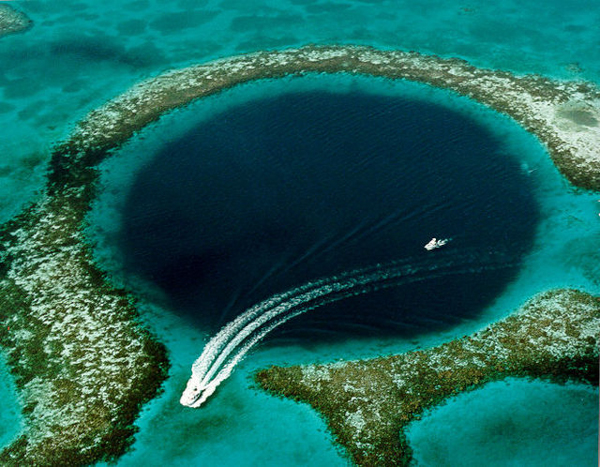 Belize’s Great Blue Hole, part of a UNESCO World Heritage Site that would be included in areas opened to oil and gas drilling under a new proposal from the Belizean government. Photo credit: U.S. Geological Survey. The government of Belize has proposed opening up most of the country’s marine area, including seven areas comprising a […]
Belize’s Great Blue Hole, part of a UNESCO World Heritage Site that would be included in areas opened to oil and gas drilling under a new proposal from the Belizean government. Photo credit: U.S. Geological Survey. The government of Belize has proposed opening up most of the country’s marine area, including seven areas comprising a […]
Innovative community fisheries initiative wins top social entrepreneurship prize
 Hanging an octopus to dry. Courtesy of the Skoll Foundation. A program that helps restore overfished areas through community-based marine conservation has won the Skoll Foundation’s top prize for social entrepreneurship. Today the Skoll announced Blue Ventures, which piloted its approach in Madagascar a decade ago before expanding to other regions, was one of four […]
Hanging an octopus to dry. Courtesy of the Skoll Foundation. A program that helps restore overfished areas through community-based marine conservation has won the Skoll Foundation’s top prize for social entrepreneurship. Today the Skoll announced Blue Ventures, which piloted its approach in Madagascar a decade ago before expanding to other regions, was one of four […]
Rainforest loss increased in the 2000s, concludes new analysis
 Click charts to enlarge Loss of tropical forests accelerated roughly 60 percent during the 2000s, argues a paper published in the journal Geophysical Research Letters. The findings contradict previous research suggesting that deforestation slowed since the 1990s. The study is based on a map of 1990 forest cover developed last year by Do-Hyung Kim and […]
Click charts to enlarge Loss of tropical forests accelerated roughly 60 percent during the 2000s, argues a paper published in the journal Geophysical Research Letters. The findings contradict previous research suggesting that deforestation slowed since the 1990s. The study is based on a map of 1990 forest cover developed last year by Do-Hyung Kim and […]
Pollution from fossil fuels decreased rainfall in Central America
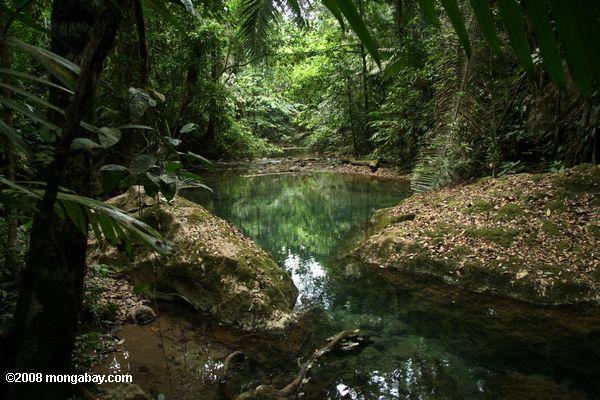 Jungle in Belize. New research finds Belize has been drying out for over a century, likely due to pollution from burning fossil fuels in the northern hemisphere which has left to a shift in the a vital precipitation belt along the equator. Photo by: Rhett A. Butler. Fossil fuel pollution may have caused a southern […]
Jungle in Belize. New research finds Belize has been drying out for over a century, likely due to pollution from burning fossil fuels in the northern hemisphere which has left to a shift in the a vital precipitation belt along the equator. Photo by: Rhett A. Butler. Fossil fuel pollution may have caused a southern […]
What makes the jaguar the ultimate survivor? New books highlights mega-predator’s remarkable past and precarious future
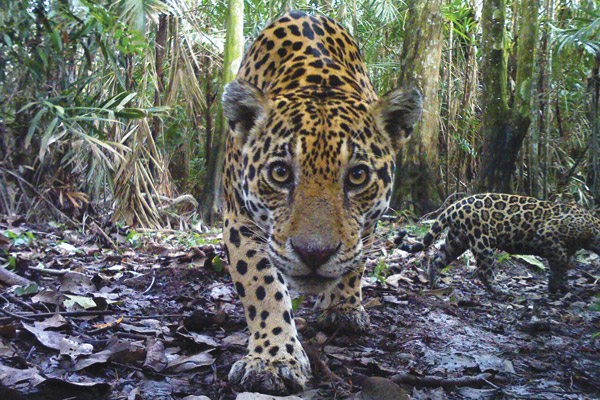 An interview with Alan Rabinowitz, author of the new book, An Indomitable Beast: the Journey of the Jaguar Female jaguar (staring into camera) with subadult male offspring moving through an old oil palm plantation in the jaguar corridor of Colombia. Photo by: Esteban Payan, Panthera. For thousands of years the jaguar was a God, then […]
An interview with Alan Rabinowitz, author of the new book, An Indomitable Beast: the Journey of the Jaguar Female jaguar (staring into camera) with subadult male offspring moving through an old oil palm plantation in the jaguar corridor of Colombia. Photo by: Esteban Payan, Panthera. For thousands of years the jaguar was a God, then […]
Emissions from rainforest logging average 16% of those from deforestation
 Rainforest logging in Borneo Carbon emissions from selective logging operations in tropical rainforests are roughly a sixth of those from outright forest clearing, finds a new study that evaluated 13 forestry concessions in six countries. The study, published in the journal Environmental Research Letters by scientists from Winrock International, analyzed carbon losses from different aspects […]
Rainforest logging in Borneo Carbon emissions from selective logging operations in tropical rainforests are roughly a sixth of those from outright forest clearing, finds a new study that evaluated 13 forestry concessions in six countries. The study, published in the journal Environmental Research Letters by scientists from Winrock International, analyzed carbon losses from different aspects […]
Mesoamerican Reef needs more local support, says report
 From massive hotel development through the agriculture industry, humans are destroying the second largest barrier reef in the world: the Mesoamerican Reef. Although global climate change and its effects on reefs via warming and acidification of coastal waters have made recent headlines, local human activities may destroy certain ecosystems before climate change has a chance […]
From massive hotel development through the agriculture industry, humans are destroying the second largest barrier reef in the world: the Mesoamerican Reef. Although global climate change and its effects on reefs via warming and acidification of coastal waters have made recent headlines, local human activities may destroy certain ecosystems before climate change has a chance […]
Rosewood in Belize: the truth behind the smoke
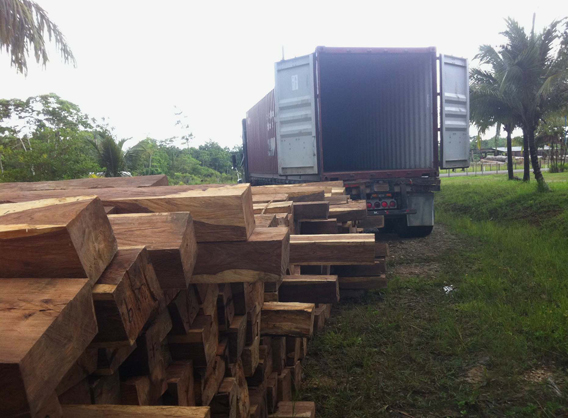 Rosewood logging in Belize. Photo by: Will Maheia. In Belize, the uncontrolled and often illegal harvesting of rosewood has been, and still is, one of the major environmental issues in the country. In March of last year, the government established a moratorium on the export and extraction of rosewood, however illegal harvesting continued. On Friday […]
Rosewood logging in Belize. Photo by: Will Maheia. In Belize, the uncontrolled and often illegal harvesting of rosewood has been, and still is, one of the major environmental issues in the country. In March of last year, the government established a moratorium on the export and extraction of rosewood, however illegal harvesting continued. On Friday […]
Oil drilling approved for national park in Belize
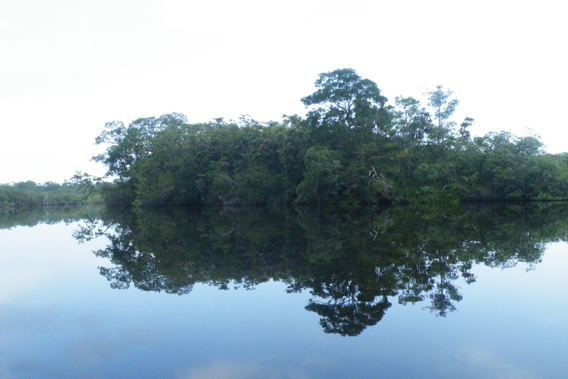 Dawn breaking over Black Creek, Sarstoon Temash National Park. Photo by: Robin Oisín Llewellyn. The Belizean government has approved an application by US Capital Energy to drill exploratory wells for oil in the Sarstoon Temash National Park in southern Belize. The decision is believed to have been taken on November 1st by the National Environmental […]
Dawn breaking over Black Creek, Sarstoon Temash National Park. Photo by: Robin Oisín Llewellyn. The Belizean government has approved an application by US Capital Energy to drill exploratory wells for oil in the Sarstoon Temash National Park in southern Belize. The decision is believed to have been taken on November 1st by the National Environmental […]
Deforestation accelerates in Belize
 Deforestation in Belize has accelerated since late 2010, reports a new satellite-based assessment of the tiny Central American country’s forest cover by CATHALAC (the Water Center for the Humid Tropics of Latin America and the Caribbean). The analysis used NASA Landsat-7 imagery to compare forest cover between early 2010 and early 2012. It concludes that […]
Deforestation in Belize has accelerated since late 2010, reports a new satellite-based assessment of the tiny Central American country’s forest cover by CATHALAC (the Water Center for the Humid Tropics of Latin America and the Caribbean). The analysis used NASA Landsat-7 imagery to compare forest cover between early 2010 and early 2012. It concludes that […]
Oil company blamed for fire in Belize national park
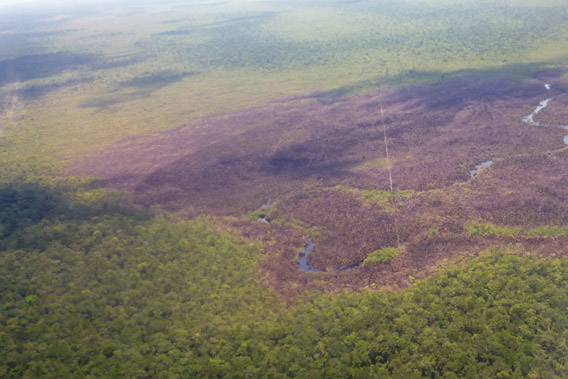 Aerial view of the burned bog in Sarstoon Temash National Park. Prior to burning, the bog would have appeared florescent green due to the sphanum moss. Photo by: SATIIM. At the end of March in southern Belize the sun beats down through blackened trees onto what was the only known low-lying sphagnum moss bog in […]
Aerial view of the burned bog in Sarstoon Temash National Park. Prior to burning, the bog would have appeared florescent green due to the sphanum moss. Photo by: SATIIM. At the end of March in southern Belize the sun beats down through blackened trees onto what was the only known low-lying sphagnum moss bog in […]
Belize enacts moratorium on rosewood
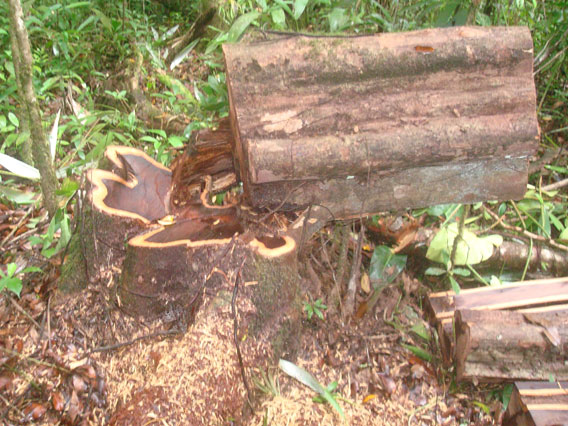 Illegally harvested rosewood from the Sarstoon Temash National Park in Belize. Photo by: Anisario Cal. The Belizean Government has banned the harvesting and export of rosewood with immediate effect, in response to the widespread clearing of the hardwood species for the Asian market. A government statement released on Friday, March 16th claimed the moratorium was […]
Illegally harvested rosewood from the Sarstoon Temash National Park in Belize. Photo by: Anisario Cal. The Belizean Government has banned the harvesting and export of rosewood with immediate effect, in response to the widespread clearing of the hardwood species for the Asian market. A government statement released on Friday, March 16th claimed the moratorium was […]
Airborne lasers discover undocumented deforestation in Belize park
 Slash-and-burn agriculture in Belize. Photo by: Rhett A. Butler. A NASA funded expedition using airborne lasers to study ancient Mayan ruins has also documented widespread illegal deforestation in the Caracol Archaeological Reserve. The lasers found that forest disturbance was actually 58 percent greater than recent satellite surveys showed, according new study in mongabay.com’s open access […]
Slash-and-burn agriculture in Belize. Photo by: Rhett A. Butler. A NASA funded expedition using airborne lasers to study ancient Mayan ruins has also documented widespread illegal deforestation in the Caracol Archaeological Reserve. The lasers found that forest disturbance was actually 58 percent greater than recent satellite surveys showed, according new study in mongabay.com’s open access […]
Camera traps go under the ocean, seeking sharks
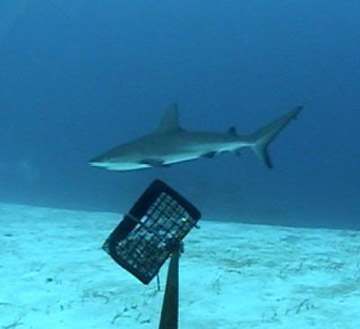 Remote camera traps, which have become a hugely important conservation tool on land during the past decade, have now gone underwater. Marine biologists have used underwater video camera traps to compare the population of Caribbean reef sharks (Carcharhinus perezii) in Belize’s protected areas versus fishing areas in a new study in the open-access journal PLoS […]
Remote camera traps, which have become a hugely important conservation tool on land during the past decade, have now gone underwater. Marine biologists have used underwater video camera traps to compare the population of Caribbean reef sharks (Carcharhinus perezii) in Belize’s protected areas versus fishing areas in a new study in the open-access journal PLoS […]
Photo: new cookies-and-cream insect surprises researchers in Belize
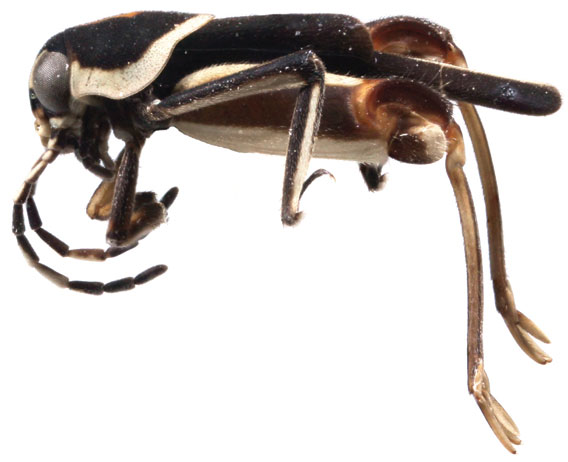 Ripipteryx mopana, a new species discovered in Belize. Photo by: Sam W. Heads, Steven J. Taylor. Scientists have discovered the first ever insect in the Ripipterygidae family in Belize. Measuring only 5 millimeters (0.19 inches), the tiny insect uses its powerful legs to leap away from predators much like a grasshopper. In fact, the new […]
Ripipteryx mopana, a new species discovered in Belize. Photo by: Sam W. Heads, Steven J. Taylor. Scientists have discovered the first ever insect in the Ripipterygidae family in Belize. Measuring only 5 millimeters (0.19 inches), the tiny insect uses its powerful legs to leap away from predators much like a grasshopper. In fact, the new […]
Seismic trails cut by U.S. oil firm in Belizean national park used by illegal loggers
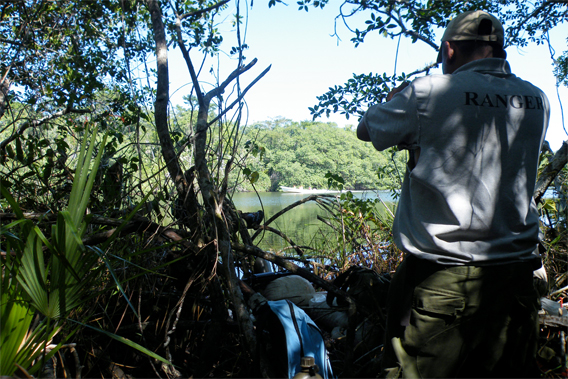 Ranger photographing US Capital Energy workers. Photo by Robin Oisín Llewellyn. In the Belizean rainforest two rangers look up and down a straight path hacked through the jungle and take GPS coordinates, the escorting soldiers lying back in the heat as the coordinates are delivered. These are noted and the patrol resumes, pausing to photograph […]
Ranger photographing US Capital Energy workers. Photo by Robin Oisín Llewellyn. In the Belizean rainforest two rangers look up and down a straight path hacked through the jungle and take GPS coordinates, the escorting soldiers lying back in the heat as the coordinates are delivered. These are noted and the patrol resumes, pausing to photograph […]
Turkey picture for Thanksgiving
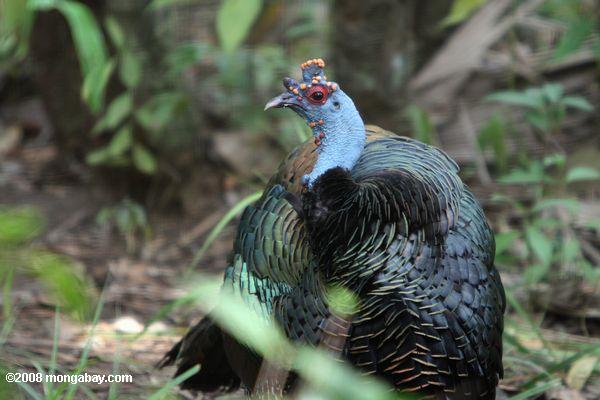 Ocellated Turkey (Meleagris ocellata) in Belize. Photo by Rhett Butler. In recognition of the American holiday of Thanksgiving, this is the ocellated turkey (Meleagris ocellata), a species of wild turkey from the Yucatán Peninsula in Central America, including parts of Mexico, Guatemala, and Belize. The ocellated turkey is closely related to the more widely-distributed, and […]
Ocellated Turkey (Meleagris ocellata) in Belize. Photo by Rhett Butler. In recognition of the American holiday of Thanksgiving, this is the ocellated turkey (Meleagris ocellata), a species of wild turkey from the Yucatán Peninsula in Central America, including parts of Mexico, Guatemala, and Belize. The ocellated turkey is closely related to the more widely-distributed, and […]
Harpy eagles nest in Belize for the first time in over 60 years (pictures)
 Scientists have confirmed the presence of a harpy eagle nest in the Maya Mountains of Belize. The discovery represents the most northerly breeding pair in the Americas, and signals a comeback for a species which has become locally extinct in much of Central America due to human activity. With wingspans seven feet long and the […]
Scientists have confirmed the presence of a harpy eagle nest in the Maya Mountains of Belize. The discovery represents the most northerly breeding pair in the Americas, and signals a comeback for a species which has become locally extinct in much of Central America due to human activity. With wingspans seven feet long and the […]
Pictures: Belize Zoo devastated by hurricane
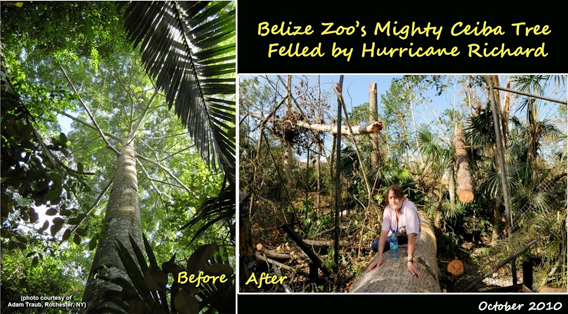 This Ceiba tree fell on the jaguar Junior Buddy’s exhibit during Hurricane Richard; Junior was unharmed. Note the fencing on the right. Image and caption courtesy of the Belize Zoo The world famous Belize Zoo is closed until further notice after suffering a direct hit from Hurricane Richard, which leveled trees and inflicted heavy damage […]
This Ceiba tree fell on the jaguar Junior Buddy’s exhibit during Hurricane Richard; Junior was unharmed. Note the fencing on the right. Image and caption courtesy of the Belize Zoo The world famous Belize Zoo is closed until further notice after suffering a direct hit from Hurricane Richard, which leveled trees and inflicted heavy damage […]
Belize lost 10,000 ha of forest per year since 1980
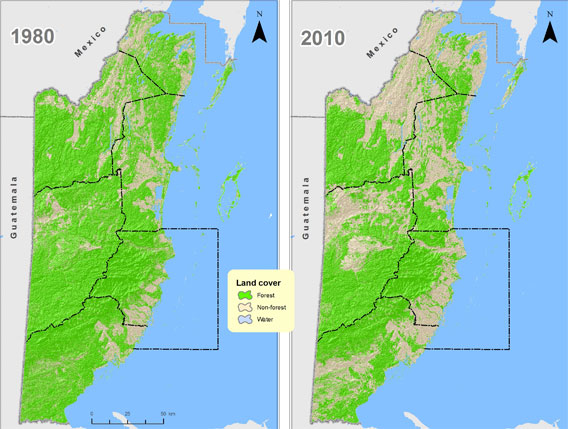 Deforestation in Belize amounts to an area the size of Rhode Island since 1980, according to new assessment. Forests in Belize have been cleared at a rate of nearly 10,000 hectares per year for the past 30 years, a recent study shows. In 1980, forests covered 79.5% of the land surface of Belize but as […]
Deforestation in Belize amounts to an area the size of Rhode Island since 1980, according to new assessment. Forests in Belize have been cleared at a rate of nearly 10,000 hectares per year for the past 30 years, a recent study shows. In 1980, forests covered 79.5% of the land surface of Belize but as […]
New species of glowing mushrooms named after Mozart’s Requiem
 Classical musical genius, Wolfgang Amadeus Mozart, probably never expected his music to inspire mycologists, but fungi researchers have announced in the journal Mycologia that two new species of glowing mushroom are named after movements in the composer’s Requiem: Mycena luxaeterna (eternal light) and Mycena luxperpetua (perpetual light). The glowing fungi species—seven in total—were discovered in […]
Classical musical genius, Wolfgang Amadeus Mozart, probably never expected his music to inspire mycologists, but fungi researchers have announced in the journal Mycologia that two new species of glowing mushroom are named after movements in the composer’s Requiem: Mycena luxaeterna (eternal light) and Mycena luxperpetua (perpetual light). The glowing fungi species—seven in total—were discovered in […]
New protections for coral reefs and dwindling fish species in Belize
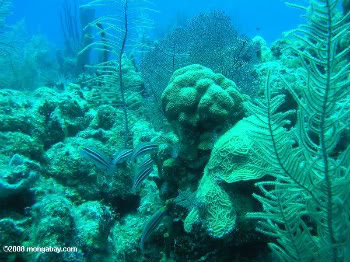 Coral reefs in Belize, considered to be some of the most pristine in the west, have secured additional protections. Rene Montero, the Minister of Agriculture and Fisheries, signed a set of new laws this month to protect Belize’s coral reefs and the fish that inhabit them. The additional laws protect increasingly overfished species, ban spearfishing […]
Coral reefs in Belize, considered to be some of the most pristine in the west, have secured additional protections. Rene Montero, the Minister of Agriculture and Fisheries, signed a set of new laws this month to protect Belize’s coral reefs and the fish that inhabit them. The additional laws protect increasingly overfished species, ban spearfishing […]
Territorial disputes and conservation
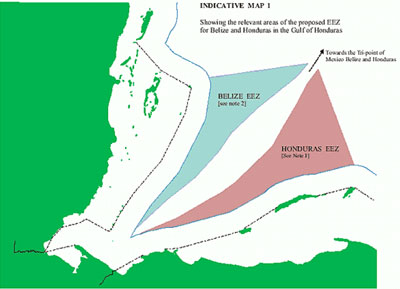 Political drivers such as those related to territorial disputes between tropical countries can result in direct and indirect ramifications negatively impacting conservation of native ecosystems report Arlenie Perez, Chuang Chin-Ta and Farok Afero in the March issue of the open access journal Tropical Conservation Science. Arlenie Perez and colleagues document the historical and political base […]
Political drivers such as those related to territorial disputes between tropical countries can result in direct and indirect ramifications negatively impacting conservation of native ecosystems report Arlenie Perez, Chuang Chin-Ta and Farok Afero in the March issue of the open access journal Tropical Conservation Science. Arlenie Perez and colleagues document the historical and political base […]
Coral reefs and mangroves worth $395-559 M per year in Belize
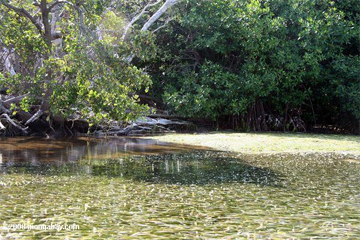 Services provided by coral reefs and mangroves in Belize are worth US$395 million to US$559 million per year, or 30 to 45 percent of the Central American country's GDP — according to a new report released by the World Resources Institute and the World Wildlife Fund. The study assessed the value of ecosystem services — […]
Services provided by coral reefs and mangroves in Belize are worth US$395 million to US$559 million per year, or 30 to 45 percent of the Central American country's GDP — according to a new report released by the World Resources Institute and the World Wildlife Fund. The study assessed the value of ecosystem services — […]
Feeds: news | india | latam | brasil | indonesia
 The most popular stories from our Spanish-language service, Mongabay Latam, followed a new green-eyed shark species in Belize, salmon farms in Patagonia, blast fishing in Peru, a cocaine-laden plane in a Peruvian park, and an Andean bear mystery, also in Peru. Belize’s tiny sixgill shark species at risk “A little shark so adorable, you want […]
The most popular stories from our Spanish-language service, Mongabay Latam, followed a new green-eyed shark species in Belize, salmon farms in Patagonia, blast fishing in Peru, a cocaine-laden plane in a Peruvian park, and an Andean bear mystery, also in Peru. Belize’s tiny sixgill shark species at risk “A little shark so adorable, you want […] The most popular stories from our Spanish-language service, Mongabay-Latam, this past week investigated how land trafficking is destroying Lima’s fragile hill ecosystems; government inaction and oil spills in Venezuela; open borders for wildlife trafficking in Belize and Guatemala; massive floods in Colombia; and community reforestation in Bolivia. Land trafficking erodes Lima’s fragile hill ecosystems Land […]
The most popular stories from our Spanish-language service, Mongabay-Latam, this past week investigated how land trafficking is destroying Lima’s fragile hill ecosystems; government inaction and oil spills in Venezuela; open borders for wildlife trafficking in Belize and Guatemala; massive floods in Colombia; and community reforestation in Bolivia. Land trafficking erodes Lima’s fragile hill ecosystems Land […] Belize’s Great Blue Hole, part of a UNESCO World Heritage Site that would be included in areas opened to oil and gas drilling under a new proposal from the Belizean government. Photo credit: U.S. Geological Survey. The government of Belize has proposed opening up most of the country’s marine area, including seven areas comprising a […]
Belize’s Great Blue Hole, part of a UNESCO World Heritage Site that would be included in areas opened to oil and gas drilling under a new proposal from the Belizean government. Photo credit: U.S. Geological Survey. The government of Belize has proposed opening up most of the country’s marine area, including seven areas comprising a […] Hanging an octopus to dry. Courtesy of the Skoll Foundation. A program that helps restore overfished areas through community-based marine conservation has won the Skoll Foundation’s top prize for social entrepreneurship. Today the Skoll announced Blue Ventures, which piloted its approach in Madagascar a decade ago before expanding to other regions, was one of four […]
Hanging an octopus to dry. Courtesy of the Skoll Foundation. A program that helps restore overfished areas through community-based marine conservation has won the Skoll Foundation’s top prize for social entrepreneurship. Today the Skoll announced Blue Ventures, which piloted its approach in Madagascar a decade ago before expanding to other regions, was one of four […] Click charts to enlarge Loss of tropical forests accelerated roughly 60 percent during the 2000s, argues a paper published in the journal Geophysical Research Letters. The findings contradict previous research suggesting that deforestation slowed since the 1990s. The study is based on a map of 1990 forest cover developed last year by Do-Hyung Kim and […]
Click charts to enlarge Loss of tropical forests accelerated roughly 60 percent during the 2000s, argues a paper published in the journal Geophysical Research Letters. The findings contradict previous research suggesting that deforestation slowed since the 1990s. The study is based on a map of 1990 forest cover developed last year by Do-Hyung Kim and […] An interview with Alan Rabinowitz, author of the new book, An Indomitable Beast: the Journey of the Jaguar Female jaguar (staring into camera) with subadult male offspring moving through an old oil palm plantation in the jaguar corridor of Colombia. Photo by: Esteban Payan, Panthera. For thousands of years the jaguar was a God, then […]
An interview with Alan Rabinowitz, author of the new book, An Indomitable Beast: the Journey of the Jaguar Female jaguar (staring into camera) with subadult male offspring moving through an old oil palm plantation in the jaguar corridor of Colombia. Photo by: Esteban Payan, Panthera. For thousands of years the jaguar was a God, then […] Rainforest logging in Borneo Carbon emissions from selective logging operations in tropical rainforests are roughly a sixth of those from outright forest clearing, finds a new study that evaluated 13 forestry concessions in six countries. The study, published in the journal Environmental Research Letters by scientists from Winrock International, analyzed carbon losses from different aspects […]
Rainforest logging in Borneo Carbon emissions from selective logging operations in tropical rainforests are roughly a sixth of those from outright forest clearing, finds a new study that evaluated 13 forestry concessions in six countries. The study, published in the journal Environmental Research Letters by scientists from Winrock International, analyzed carbon losses from different aspects […] From massive hotel development through the agriculture industry, humans are destroying the second largest barrier reef in the world: the Mesoamerican Reef. Although global climate change and its effects on reefs via warming and acidification of coastal waters have made recent headlines, local human activities may destroy certain ecosystems before climate change has a chance […]
From massive hotel development through the agriculture industry, humans are destroying the second largest barrier reef in the world: the Mesoamerican Reef. Although global climate change and its effects on reefs via warming and acidification of coastal waters have made recent headlines, local human activities may destroy certain ecosystems before climate change has a chance […] Rosewood logging in Belize. Photo by: Will Maheia. In Belize, the uncontrolled and often illegal harvesting of rosewood has been, and still is, one of the major environmental issues in the country. In March of last year, the government established a moratorium on the export and extraction of rosewood, however illegal harvesting continued. On Friday […]
Rosewood logging in Belize. Photo by: Will Maheia. In Belize, the uncontrolled and often illegal harvesting of rosewood has been, and still is, one of the major environmental issues in the country. In March of last year, the government established a moratorium on the export and extraction of rosewood, however illegal harvesting continued. On Friday […] Dawn breaking over Black Creek, Sarstoon Temash National Park. Photo by: Robin Oisín Llewellyn. The Belizean government has approved an application by US Capital Energy to drill exploratory wells for oil in the Sarstoon Temash National Park in southern Belize. The decision is believed to have been taken on November 1st by the National Environmental […]
Dawn breaking over Black Creek, Sarstoon Temash National Park. Photo by: Robin Oisín Llewellyn. The Belizean government has approved an application by US Capital Energy to drill exploratory wells for oil in the Sarstoon Temash National Park in southern Belize. The decision is believed to have been taken on November 1st by the National Environmental […] Aerial view of the burned bog in Sarstoon Temash National Park. Prior to burning, the bog would have appeared florescent green due to the sphanum moss. Photo by: SATIIM. At the end of March in southern Belize the sun beats down through blackened trees onto what was the only known low-lying sphagnum moss bog in […]
Aerial view of the burned bog in Sarstoon Temash National Park. Prior to burning, the bog would have appeared florescent green due to the sphanum moss. Photo by: SATIIM. At the end of March in southern Belize the sun beats down through blackened trees onto what was the only known low-lying sphagnum moss bog in […] Illegally harvested rosewood from the Sarstoon Temash National Park in Belize. Photo by: Anisario Cal. The Belizean Government has banned the harvesting and export of rosewood with immediate effect, in response to the widespread clearing of the hardwood species for the Asian market. A government statement released on Friday, March 16th claimed the moratorium was […]
Illegally harvested rosewood from the Sarstoon Temash National Park in Belize. Photo by: Anisario Cal. The Belizean Government has banned the harvesting and export of rosewood with immediate effect, in response to the widespread clearing of the hardwood species for the Asian market. A government statement released on Friday, March 16th claimed the moratorium was […] Remote camera traps, which have become a hugely important conservation tool on land during the past decade, have now gone underwater. Marine biologists have used underwater video camera traps to compare the population of Caribbean reef sharks (Carcharhinus perezii) in Belize’s protected areas versus fishing areas in a new study in the open-access journal PLoS […]
Remote camera traps, which have become a hugely important conservation tool on land during the past decade, have now gone underwater. Marine biologists have used underwater video camera traps to compare the population of Caribbean reef sharks (Carcharhinus perezii) in Belize’s protected areas versus fishing areas in a new study in the open-access journal PLoS […] Ripipteryx mopana, a new species discovered in Belize. Photo by: Sam W. Heads, Steven J. Taylor. Scientists have discovered the first ever insect in the Ripipterygidae family in Belize. Measuring only 5 millimeters (0.19 inches), the tiny insect uses its powerful legs to leap away from predators much like a grasshopper. In fact, the new […]
Ripipteryx mopana, a new species discovered in Belize. Photo by: Sam W. Heads, Steven J. Taylor. Scientists have discovered the first ever insect in the Ripipterygidae family in Belize. Measuring only 5 millimeters (0.19 inches), the tiny insect uses its powerful legs to leap away from predators much like a grasshopper. In fact, the new […] Ranger photographing US Capital Energy workers. Photo by Robin Oisín Llewellyn. In the Belizean rainforest two rangers look up and down a straight path hacked through the jungle and take GPS coordinates, the escorting soldiers lying back in the heat as the coordinates are delivered. These are noted and the patrol resumes, pausing to photograph […]
Ranger photographing US Capital Energy workers. Photo by Robin Oisín Llewellyn. In the Belizean rainforest two rangers look up and down a straight path hacked through the jungle and take GPS coordinates, the escorting soldiers lying back in the heat as the coordinates are delivered. These are noted and the patrol resumes, pausing to photograph […] Scientists have confirmed the presence of a harpy eagle nest in the Maya Mountains of Belize. The discovery represents the most northerly breeding pair in the Americas, and signals a comeback for a species which has become locally extinct in much of Central America due to human activity. With wingspans seven feet long and the […]
Scientists have confirmed the presence of a harpy eagle nest in the Maya Mountains of Belize. The discovery represents the most northerly breeding pair in the Americas, and signals a comeback for a species which has become locally extinct in much of Central America due to human activity. With wingspans seven feet long and the […] This Ceiba tree fell on the jaguar Junior Buddy’s exhibit during Hurricane Richard; Junior was unharmed. Note the fencing on the right. Image and caption courtesy of the Belize Zoo The world famous Belize Zoo is closed until further notice after suffering a direct hit from Hurricane Richard, which leveled trees and inflicted heavy damage […]
This Ceiba tree fell on the jaguar Junior Buddy’s exhibit during Hurricane Richard; Junior was unharmed. Note the fencing on the right. Image and caption courtesy of the Belize Zoo The world famous Belize Zoo is closed until further notice after suffering a direct hit from Hurricane Richard, which leveled trees and inflicted heavy damage […] Deforestation in Belize amounts to an area the size of Rhode Island since 1980, according to new assessment. Forests in Belize have been cleared at a rate of nearly 10,000 hectares per year for the past 30 years, a recent study shows. In 1980, forests covered 79.5% of the land surface of Belize but as […]
Deforestation in Belize amounts to an area the size of Rhode Island since 1980, according to new assessment. Forests in Belize have been cleared at a rate of nearly 10,000 hectares per year for the past 30 years, a recent study shows. In 1980, forests covered 79.5% of the land surface of Belize but as […] Classical musical genius, Wolfgang Amadeus Mozart, probably never expected his music to inspire mycologists, but fungi researchers have announced in the journal Mycologia that two new species of glowing mushroom are named after movements in the composer’s Requiem: Mycena luxaeterna (eternal light) and Mycena luxperpetua (perpetual light). The glowing fungi species—seven in total—were discovered in […]
Classical musical genius, Wolfgang Amadeus Mozart, probably never expected his music to inspire mycologists, but fungi researchers have announced in the journal Mycologia that two new species of glowing mushroom are named after movements in the composer’s Requiem: Mycena luxaeterna (eternal light) and Mycena luxperpetua (perpetual light). The glowing fungi species—seven in total—were discovered in […] Coral reefs in Belize, considered to be some of the most pristine in the west, have secured additional protections. Rene Montero, the Minister of Agriculture and Fisheries, signed a set of new laws this month to protect Belize’s coral reefs and the fish that inhabit them. The additional laws protect increasingly overfished species, ban spearfishing […]
Coral reefs in Belize, considered to be some of the most pristine in the west, have secured additional protections. Rene Montero, the Minister of Agriculture and Fisheries, signed a set of new laws this month to protect Belize’s coral reefs and the fish that inhabit them. The additional laws protect increasingly overfished species, ban spearfishing […] Political drivers such as those related to territorial disputes between tropical countries can result in direct and indirect ramifications negatively impacting conservation of native ecosystems report Arlenie Perez, Chuang Chin-Ta and Farok Afero in the March issue of the open access journal Tropical Conservation Science. Arlenie Perez and colleagues document the historical and political base […]
Political drivers such as those related to territorial disputes between tropical countries can result in direct and indirect ramifications negatively impacting conservation of native ecosystems report Arlenie Perez, Chuang Chin-Ta and Farok Afero in the March issue of the open access journal Tropical Conservation Science. Arlenie Perez and colleagues document the historical and political base […] Services provided by coral reefs and mangroves in Belize are worth US$395 million to US$559 million per year, or 30 to 45 percent of the Central American country's GDP — according to a new report released by the World Resources Institute and the World Wildlife Fund. The study assessed the value of ecosystem services — […]
Services provided by coral reefs and mangroves in Belize are worth US$395 million to US$559 million per year, or 30 to 45 percent of the Central American country's GDP — according to a new report released by the World Resources Institute and the World Wildlife Fund. The study assessed the value of ecosystem services — […]